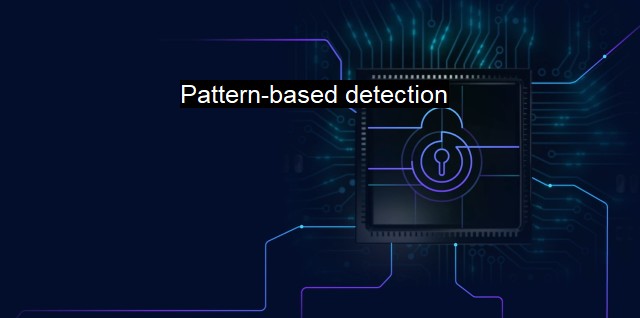What is Pattern-based detection?
Enhancing Cybersecurity with Pattern-Based Detection: Preventing Threats through Identifying and Analyzing Malicious Patterns
Pattern-based detection, commonly known as signature-based detection, is a method typically used in the cybersecurity and antivirus industry to thwart malicious software or malware. The central mechanism of pattern-based detection revolves around identifying pre-established patterns of malicious data or software. To put it in simple words, it equates to recognizing the 'DNA' or 'fingerprint' of a known malicious threat. Here, patterns refer to distinct features or characteristics also called "signatures," which are extracted and analysed from renowned and infamous malware.The functionality of pattern-based detection is unlike other antivirus techniques. Other methods will typically focus on behaviour or statistical modelling to prevent harmful attacks; instead, pattern-based detection strictly compares a potential threat against an existing database of identified malware characteristics. Each piece of malware has a unique signature, so the approach is quite efficient and effective in quarantining threats instantaneously.
Pattern-based detection can be understood as akin to fishing with a net for identifiable species of fish. Once an identification is produced, it happens instantaneously, and the fishermen (or the software, from a cybersecurity point of view) effectively isolate the catch. This resembles pattern-based detection software 'catching' and isolating the malware after instantaneously recognizing its malicious signature.
The operation of pattern-based detection involves establishing an extensive database or repository of malware virus definitions, also known as a virus dictionary or signature database. This repository is regularly updated as and when new threats emerge so that the software can promptly identify and decline newly emerging cyber threats. The antivirus probe scans the system files and compares them against the entries in the signature database. If the contents exhibit a match with known malware signatures, an alert is raised, and remedial actions such as deletion or quarantine are undertaken.
Reliance on pattern-based detection has profound significance in the realm of antivirus software. One significant advantage lies in its efficacy of recognizing known threats. This cements the idea that historic or recurring malware cannot survive or function against a well-maintained and regularly updated antivirus program. its straightforward mechanism enables consistent results across a series of varying system environments.
Pattern-based detection is not devoid of drawbacks. It falls short against new, unfamiliar threats, which lack pre-described patterns in the database. These new threats come under the term "zero-day exploits," which target vulnerabilities before a solution or patch is applied. In these instances, pattern-based detection fails as it relies exceedingly on archived patterns. Another limitation is that maintaining an exhaustive library calls for substantial storage and resources, and regular updates can often drained bandwidth.
This method is also unable to address polymorphic or metamorphic threats, where the malware alters its code to dodge detection from pattern-based detection software. Therefore, while pattern-based detection is a method with commendable precision and speed, complete reliance on it could leave systems vulnerable to newer, evasive threats.
Therefore, while pattern-based detection serves as a strong initial layer of antivirus defence, it cannot exist in isolation. To supplement the inability of pattern-based detection to counter new threats, deployment of other methods like heuristic-based, behavior-based or anomaly-based detection is significant.
To sum it up, pattern-based detection is an essential, fast, and effective method vital in an antivirus programme for safeguarding against known threats. As an analogy, if cybersecurity is a game of chess, then pattern-based detection can be seen as the pawns— fundamental, blocking the threats, but insufficient for an endgame checkmate. To counter the evolving cybersecurity landscape, a combination of defensive methods including but not limited to pattern-based detection is necessary, in tandem ensuring enhanced security conditions.

Pattern-based detection FAQs
What is pattern-based detection in cybersecurity?
Pattern-based detection is a technique used by antivirus programs and other cybersecurity tools to identify known malware by searching for specific code patterns, signatures or sequences within files or network traffic.How does pattern-based detection work?
Pattern-based detection works by comparing files or network traffic against a database of known malware signatures or patterns. If a match is found, the antivirus program or cybersecurity tool can then take appropriate action to quarantine or delete the malicious file.What are the advantages of pattern-based detection?
The advantages of pattern-based detection include its ability to quickly identify known malware and its high accuracy rate. Additionally, pattern-based detection does not require extensive resources or analysis to identify malware, making it a cost-effective cybersecurity solution.What are the limitations of pattern-based detection?
The limitations of pattern-based detection include its inability to detect new or unknown malware that does not match any existing signatures or patterns. Additionally, attackers can easily evade detection by using malware variants or by obfuscating their code to avoid detection by pattern-based techniques. As a result, pattern-based detection should be used in conjunction with other cybersecurity measures to provide comprehensive protection against evolving threats.| | A | | | B | | | C | | | D | | | E | | | F | | | G | | | H | | | I | | | J | | | K | | | L | | | M | |
| | N | | | O | | | P | | | Q | | | R | | | S | | | T | | | U | | | V | | | W | | | X | | | Y | | | Z | |
| | 1 | | | 2 | | | 3 | | | 4 | | | 7 | | | 8 | | |||||||